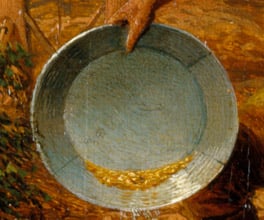Prospecting methods
Gold’s density means that given the right conditions it will fall to the bottom of a solution, allowing a miner to wash away the lighter mud and rocks and pick out individual flakes. In the richest fields, some diggers even found it lying on the surface after heavy rains.
The simplest way to find gold was to use a tin dish at the side of a stream. The best spots were gentle bends where gold had been trapped rather than travelling on with the course of the stream. With patience and a gentle rocking motion, miners successfully separated the bright gold from the dull clay of Victorian rivers. Panning also gave an indication of gold in the ground. Miners quickly moved from the rivers to sinking shallow holes in the land around the rivers. They were looking for a level of clay that often hid gold.
Ellen Clacy, who wrote a popular account of her experiences in 1853, describes men standing in the barrels and crushing the clay and dirt with their feet:
Every now and again the dirtied water is poured off gently, and with a fresh supply, which is furnished by a mate with a long-handled dipper from the stream or pool, you puddle away. The great thing is, not to be afraid of over-work, for the better the puddling is, so much more easy and profitable is the cradling.
- Ellen Clacy
Clacy, E 1853 A Lady's Visit to the Gold Diggings of Australia in 1852-53, Angus & Robertson, London.
Where water was plentiful, sluice mining or a ‘long tom’ (a stretched version of the cradle) could be used. Set over a few metres, a channel was made in the earth with a gentle slope using wood with riffles nailed to it. As long as there was a convenient water supply, two men could wash ten times as much dirt as miners using the puddling and rocker method.
Puddling was often combined with the use of a cradle. The cradle consisted of a box placed on two strips of wood with rounded edges (allowing it to be rocked from side to side) with a series of sieves and riffles to catch the gold. Lighter material was carried away with the water and heavier solids remained trapped against the riffles:
[We] observed that the attention of a great number of the diggers was directed to a little green rocker, as they called it, that is, [a] little green-painted cradle. They said that they had seen the people belonging to that green rocker wash out 7 pounds [3 kilograms] of the gold from nine tin dishes of stuff.
- William Howitt
Howitt, W 1855, Land, labor and gold, or, Two years in Victoria : with visits to Sydney and Van Diemen's Land, Ticknor and Fields, Boston.
There were plenty of schemes and cons played on the goldfields. In the account above from Howitt, he suspects that this hole was 'peppered' with gold that had already been found. There was a brisk trade in selling successful holes (or shares in these holes) to new miners.
A pound (450 grams) of gold would have been more than a labouring man’s wages for an entire year back in England.
Before miners started going deep under the ground, gravity and water were the key elements in separating gold from the earth around it. Miners were essentially creating miniature streams that trapped gold in grooves or riffles, mimicking the bends and pools where gold had accumulated in nature.











